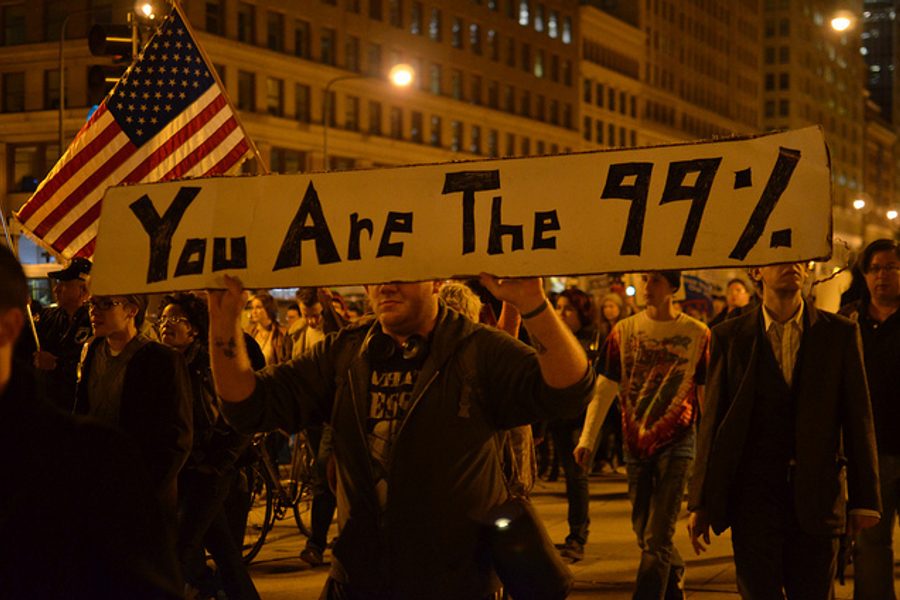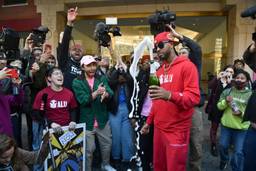
Something is happening. Socialism is no longer a dirty word (the “S-word”), but something a sizeable portion of Americans tell pollsters is their preferred vision for society. It’s no longer an anachronism to speak of “the Left.” A brave and quickly organized movement for black lives has not only sparked a new civil rights movement but has gotten many of us to see the criminal justice system for what it is: the evolution of Jim Crow. Oh, and a hell of a lot more workers are striking than before.
There have been attempts to describe this emerging movement for social justice in book form before. The latest, Necessary Trouble: Americans in Revolt by Sarah Jaffe, is the best so far. The Nation Books publication was released Tuesday.
Jaffe, a freelance writer whose work has appeared everywhere from In These Times to The Guardian and The Atlantic, is a leading light in the new generation of labor and social justice reporters. It wasn’t that long ago that if you had a campaign you wanted to get in the press you had exactly two full-time labor reporters to lobby to convince them that your campaign was interesting enough to warrant fighting with their editors to get it in print.
Now our movement has a slew of journalists who dig deep and follow campaigns and movements over the long haul. The result is not just that good campaigns get press attention, but that movements grow and expand as people read about them and get inspired to join or do something similar.
Jaffe has a good eye for characters and a great ear for what they have to say, making Necessary Trouble a very engaging read. She weaves a narrative that connects the 2008 economic collapse to the outrage that gave rise to the Tea Party, the Wisconsin protests against Scott Walker’s union-busting agenda and Occupy Wall Street. The movement for black lives, the Occupy Homes protests against bank foreclosures, the occupation of the Republic Windows and Doors factory in Chicago, student debt protests, the Chicago teachers strike(s) and the rolling strikes led by OUR Walmart and the Fight for $15, Jaffe argues, are all connected to a growing sense among Americans that the rules of the system are rigged against the working class — and doubly or triply so against workers who are black, queer, young, old, immigrants or women.
These movements are often “analyzed as if they had each happened in a vacuum,” she writes. “But in fact, as I followed them through the years, I would find similar patterns and even direct connections between them.”
The connections come, in part, to activists’ increasing understanding of “intersectionality.” That is, according to Jaffe, a term used by protestors to describe the way that people experience different forms of oppression (say, racism and sexism) as “intertwined, overlapping experiences.”
Intersectionality has become a mainstream enough concept that even Hillary Clinton felt the need to pay lip service to it on the campaign trail. “This generation,” notes City University of New York professor Ruth Milkman, “uses the word intersectionality as if it were a household label.” Jaffe makes a good case that this is a strength of the emerging movement.
Another concept that Jaffe emphasizes in her book is “horizontalism” in social movement structures. She defines the term as broad-based democratic decision-making without formalized leadership — where any member is free to speak out, propose and carry out a movement action.
“The ideal of horizontalism,” Jaffe writes “is connected to the sense that democracy, in this country, is failing, or perhaps, as some are coming to believe, that it never really worked.”
She points to Occupy Wall Street as the most obvious example of the movement’s horizontalism and experimentation with democracy. Occupy, I must say, never struck me as particularly new. It’s more like a welcome return of the Direct Action Network (DAN). Never a formal organization, the activist network was responsible for the 1999 Seattle protests that shut down a meeting of the World Trade Organization and went on to disrupt meetings of the World Bank and International Monetary Fund and the Republican and Democratic conventions.
The lack of elected leaders, the consensus decision-making with “blocking concerns” and “stand asides” — even the “spirit fingers” to silently mark agreement — all of it first appeared in the DNA of DAN. The fact that a decade and a half later we are still reinventing the same wheel suggests the need for some more permanent organizations.
Jaffe agrees. “The next challenge for the movements,” she writes, “will be creating organizations that last, that suit the needs of twenty-first-century troublemakers, that can be flexible and still enduring, that can overlap and connect up with one another and create more long-term plans for the future they want to see.”
There is a deep-seated aversion to formal organization on the Left. Part of it is, as Jaffe notes, the fear of a movement becoming dominated by “charismatic leaders.” But part of it too, I think, is charismatic leaders not wanting to deal with the indignities of democratic accountability.
I worry that Jaffe’s readers will take the word “horizontalism” and use it to justify and fetishize a lack of formal organization. A better word, I think, is one she quotes to describe the movement for black lives: “leaderfull.” That is a concept that doesn’t preclude dues-paying membership, elected committees and formalized leadership. It’s more about maintaining a culture where good ideas, speakers and writers that come “from the floor” are not merely tolerated but actively solicited.
Two good examples of leaderfull organizing that Jaffe highlights come from labor. In 2008, the workers at Chicago’s Republic Windows and Doors factory engaged in a sit-down strike. Their leaders at the United Electrical, Radio and Machine Workers of America union (UE) had proposed a small, symbolic civil disobedience action. The workers took that idea and ran with it — locking the bosses out and eventually winning their owed severance. They even got a shot at running the business themselves as a cooperative.
The second example was in 2012, when the Chicago Teachers Union (CTU) struck against Rahm Emanuel’s giveback demands. Rank-and-file activists engaged in some pretty deep coalition building and picket captains were given wide latitude with how to conduct their protests. The result was a traditional union strike that got converted into a community protest against austerity and corporate “ed reform.”
There’s no shortage of formal structure and elected leaders in labor. And while the UE and CTU are obviously exceptional unions, leaderfull organizing is more prevalent (and certainly has more potential) than is commonly recognized.
To her credit, union activists and campaigns are described throughout Jaffe’s narrative as essential to a movement fighting for an end to injustice and inequality. But I’m slightly disappointed that she didn’t delve into the recent rise in strike activity. Many of these strikes — like at Kohler and Verizon — were big, visible wins for workers.
There’s been so much written about worker centers and “alt labor” that it’s beginning to skew the market for labor writing. Yes, there’s a lot of action in alternative models of worker organizing, but old (not so) Big Labor is also showing encouraging signs of renewed militancy. Activists will learn from each other by example, and books like this must connect the dots.
To that point, Jaffe tells a delightful and inspiring story about the first night that then-New York Mayor Michael Bloomberg attempted to clear an Occupy encampment at the newly rechristened Liberty Park, near Wall Street, because it had to be cleaned. Occupy activists spent the night scrubbing the park down and, at dawn, were joined by hundreds of union activists, in their respective union colors, to stare down riot police. Bloomberg blinked and ordered law enforcement to withdraw. Jaffe reports that a burly orange-shirted member of the Laborers’ union turned to her to say, “This is power.”
Shaun Richman is a labor expert at SUNY Empire State University and author of Tell The Bosses We’re Coming: A New Action Plan for Workers in the 21st Century.








